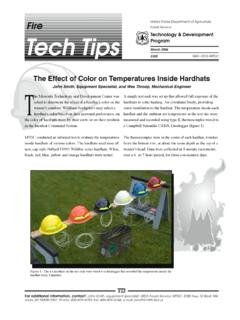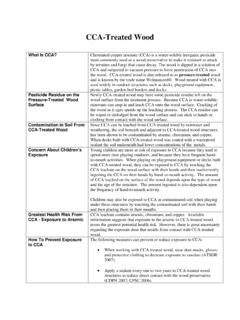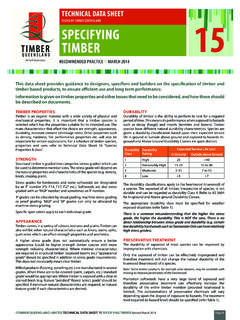Transcription of Types of Wood Preservatives - fs.fed.us
1 5 Types of Wood PreservativesCopper NaphthenateCopper naphthenate is effective when used in ground contact, water contact, or aboveground. It is not standard-ized for use in saltwater applications. Copper naphthe-nate s effectiveness as a preservative has been known since the early 1900s, and various formulations have been used commercially since the 1940s. It is an organome-tallic compound formed as a reaction product of copper salts and naphthenic acids derived from petroleum. Unlike other commercially applied wood Preservatives , small quantities of copper naphthenate can be purchased at retail hardware stores and lumberyards. Cuts or holes in treated wood can be treated in the field with copper naphthenate. Wood treated with copper naphthenate has a distinctive bright green color that weathers to light brown. The treated wood also has an odor that dissipates somewhat over time.
2 Depending on the solvent used and treatment procedures, it may be possible to paint wood treated with copper naphthenate after it has been allowed to weather for a few weeks. Copper naphthenate can be dissolved in a variety of solvents. The heavy oil solvent (specified in AWPA Stand-ard P9, Type A) or the lighter solvent (AWPA Standard P9, Type C) are the most commonly used. Copper naphthe-nate is listed in AWPA standards for treatment of major softwood species that are used for a variety of wood products. It is not listed for treatment of any hardwood species, except when the wood is used for railroad ties. The minimum copper naphthenate retentions (as elemen-tal copper) range from pounds per cubic foot ( kilograms per cubic meter) for wood used aboveground, to pounds per cubic foot (1 kilograms per cubic meter) for wood that will contact the ground and pounds per cubic foot ( kilograms per cubic meter) for wood used in critical structural applications.
3 When dissolved in No. 2 fuel oil, copper naphthenate can penetrate wood that is difficult to treat. Copper naphthenate loses some of its ability to penetrate wood when it is dissolved in heavier oils. Copper naphthenate treatments do not significantly increase the corrosion of metal fasteners relative to untreated wood. Copper naphthenate is commonly used to treat utility poles, although fewer facilities treat utility poles with copper naphthenate than with creosote or pentachlo-rophenol. Unlike creosote and pentachlorophenol, copper naphthenate is not listed as an RUP by the EPA. Even though human health concerns do not require copper naphthenate to be listed as an RUP, precautions such as the use of dust masks and gloves should be used when working with wood treated with copper naphthe-nate. Oxine Copper (Copper-8-Quinolinolate)Oxine copper is effective when used aboveground.
4 Its efficacy is reduced when it is used in direct contact with the ground or with water. It has not been standardized for those applications. Oxine copper (copper-8-quino-linolate) is an organometallic compound. The formulation consists of at least 10-percent copper-8-quinolinolate, 10-percent nickel-2-ethylhexanoate, and 80-percent inert ingredients. It is accepted as a standalone preservative for aboveground use to control sapstain fungi and mold and also is used to pressure-treat wood. Oxine copper solutions are greenish brown, odorless, toxic to both wood decay fungi and insects, and have a low toxicity to humans and animals. Oxine copper can be dissolved in a range of hydrocarbon solvents, but provides protection much longer when it is delivered in heavy oil. Oxine copper is listed in the AWPA stand-ards for treating several softwood species used in ex-posed, aboveground applications.
5 The minimum specified retention for these applications is pounds per cubic foot ( kilograms per cubic meter, as elemental cop-per). Oxine copper solutions are somewhat heat sensitive, which limits the use of heat to increase penetration of 6 Types of Wood Preservativesthe preservative. However, oxine copper can penetrate difficult-to-treat species, and is sometimes used to treat Douglas-fir used aboveground in wooden bridges and deck railings. Oilborne oxine copper does not accelerate corrosion of metal fasteners relative to untreated wood. A water-soluble form can be made with dodecylbenzene sulfonic acid, but the solution corrodes metals. Oxine copper is not widely used by pressure-treatment facilities, but is available from at least one plant on the West treated with oxine copper presents fewer toxicity or safety and handling concerns than oilborne preserva-tives that can be used in ground contact.
6 Sometimes, it is used as a preservative to control sapstain fungi or incorporated into retail stains for siding, shingles, and cabin logs. Oxine copper is listed by the Food and Drug Administration (FDA) as an indirect additive that can be used in packaging that may come in direct con-tact with such as wearing gloves and dust masks should be used when working with wood treated with oxine copper. Because of its somewhat limited use and low mammalian toxicity, there has been little research to assess the environmental impact of wood treated with oxine copper. IPBC and Insecticides IPBC (3-iodo-2-propynyl butyl carbamate) is not intended for use in ground contact or for horizontal surfaces that are fully exposed to the weather. It does provide protec-tion for wood that is aboveground and partially protected from the weather. IPBC contains 97-percent 3-iodo-2-propynyl butyl carbamate that includes a minimum of iodine.
7 IPBC industrial fungicides are broad-spectrum fungicidal additives used in architectural coatings and construction applications (such as paints, stains, adhesives, caulks, and sealants), textiles, and plastic products to prevent dry film fungal growth. The IPBC preservative is included as the primary fungi-cide in several water-repellent-preservative formula-tions under the trade name Polyphase and sold at retail stores. Although oil-soluble formulations are discussed in this report, water-based formulations also may be used. IPBC is colorless. Depending on the solvent and formu-lation, it may be possible to paint treated wood. Some formulations may have noticeable odor, but others may have little or no odor. IPBC is not an effective insecticide and is not used as a stand-alone treatment for critical structural members. IPBC is listed as a preservative in AWPA standards, but no pressure-treated wood products have been standard-ized for IPBC.
8 Dip-treating (a nonpressure process) with IPBC was standardized recently for ponderosa-pine mill-work at a minimum retention of 950 parts per million (about pounds per cubic foot [ kilograms per cubic meter]). Soil block tests indicate that IPBC can prevent fungal attack of hardwoods and softwoods when it is used at a retention of pounds per cubic foot ( kilograms per cubic meter) or higher. After 9 years of aboveground exposure tests with pressure-treated Douglas-fir, ponderosa pine, and western hemlock results indicate that mixtures of IPBC and chloropyrifos can pro-tect wood from decay at IPBC retentions as low as pounds per cubic foot ( kilograms per cubic meter). Some pressure-treating facilities use a mixture of IPBC and an insecticide, such as permethrin or chloropyrifos, to treat structural members used aboveground that will be largely protected from the weather, although this practice is not a standardized treatment.
9 These facilities are using IPBC retentions of pounds per cubic foot ( kilograms per cubic meter) or higher, with mineral spirits as the solvent. The advantage of this treatment is that it is colorless and allows the wood to maintain its natural appearance. This treatment is being used on Western species that are difficult to treat. Very few facili-ties are conducting pressure treatments with of Wood PreservativesIPBC has relatively low acute toxicity for mammals and is not classified as an EPA RUP. However, workers should follow standard precautions, such as wearing gloves and dust masks, when working with wood treated with IPBC. Because IPBC typically has not been used for pressure treatment, there has been little evaluation of the environ-mental impact of wood treated with IPBC. It appears that IPBC degrades rapidly in soil and aquatic environ-ments.
10 It has low toxicity for birds, but is highly toxic to fish and aquatic invertebrates. The relatively low IPBC concentrations used in the wood and its rapid degrada-tion in the environment would be expected to limit any environmental accumulations caused by leaching . Because IPBC usually is used with a light solvent, the preservative is not likely to bleed or ooze out of PreservativesWaterborne Preservatives react with or precipitate in treated wood, becoming fixed. They resist leaching . Because waterborne Preservatives leave a dry, paintable surface, they are commonly used to treat wood for resi-dential applications, such as decks and fences. Waterborne Preservatives are used primarily to treat softwoods, because they may not fully protect hardwoods from soft-rot attack. Most hardwood species are difficult to treat with waterborne Preservatives .











